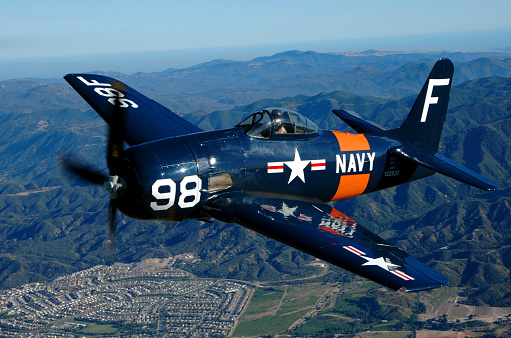
The idea behind the F8F Bearcat was conceived during a meeting between Grumman Vice President Jake Swirbul and F4F Wildcat pilots in 1942. During the meeting, it was pointed out that one of the most important requirements in the creation of a great fighter was a superior climb rate. A lighter aircraft equipped with an incredibly powerful engine would achieve a power to weight ratio that would allow the aircraft to climb faster than others in the sky – and thus outperform them. Fighting in the Pacific theater also required lighter aircraft that could be stationed and deployed via aircraft carriers.
The Bearcat went into production in 1943 after a year of intensive development and research. Two prototypes were ordered, and the first flew in August of 1944. During that flight, the prototype achieved a 4,800 feet per minute climb rate and max speed of 424 miles per hour. Though it didn’t achieve high marks for speed (the Vought F4U Corsair was faster), it did have a greater climb rate, and its lower weight made it easier to maneuver, too.
The Navy ordered over 2,000 aircraft in February of 1945 and deliveries began in May of 1945, just four months before the end of the war. While this single-engine carrier based fighter’s late start meant it didn’t serve long during the war, it would go on to serve throughout the 1950’s in the U.S. Navy and Marine Corps, as well as in air force squadrons around the world. Several modified versions were created, including the F8F-2, which delivered a little more power and differing vertical fin and cowling designs. An unmodified version of the aircraft also set a time-to-climb record in 1946 of 10,000 feet in 94 seconds, a climb record that the Bearcat would hold for 10 years. Production of this old warbird ended in 1949 and the last of the Bearcats serving on carriers were retired in 1952 and sold or repurposed for other uses.
The lighter frame and powerful engine have made it a favorite among World War II aviation enthusiasts. Bearcats are hugely popular among air racing professionals. A Bearcat flown by Mira Slovak won the first Reno Air Race in 1964, and modified versions have been flown in multiple award-winning races by pilots like Lyle Shelton and Darryl Greenamyer.